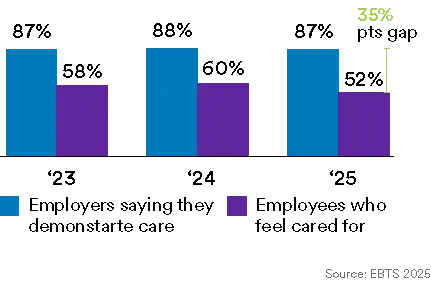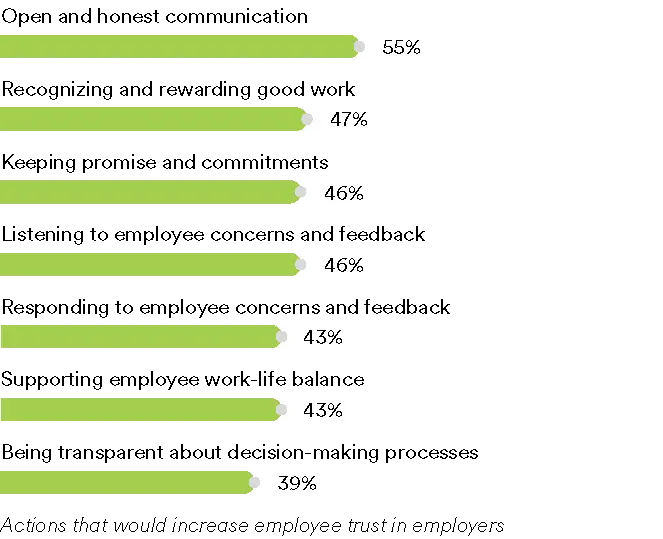Leading a changing workforce in turbulent times
New data from the MetLife 2025 U.S. Employee Benefit Trends Study (EBTS) paints a grim picture of employee well-being. Can PEOs help turn things around?
It seemed only yesterday that Millennials outnumbered Baby Boomers in the workplace. But that was 10 years ago1 . Now, Gen Z (born between 1997 and 2012) has crossed that milestone, representing 18% of the workforce compared to Baby Boomers’ 15%2 . And projections indicate that Gen Z will constitute one-third of all employees by 20303.
Unlike Millennials, who entered a recovering economy in 2014 characterized by low inflation and stable costs, Gen Z faces considerably more challenging economic conditions. Today’s workforce navigates substantial economic uncertainty stemming from policy shifts, tariff implementations, and escalating inflation rates. These factors have collectively slowed economic growth while simultaneously increasing living expenses.
This challenging environment has taken a toll on employee wellness across multiple dimensions, including mental and social health. According to the MetLife 2025 US Employee Benefit Trends Study, overall employee well-being has declined to its lowest point in five years, dropping five percentage points year-on-year. The study also reveals a growing disconnect between employers’ perceptions of workplace care and employees’ actual experiences.
What are the factors affecting employee well-being? And how can PEOs better support worksite employees? Let’s take a closer look at the data.
Only 39% of employees are “holistically healthy”4
The proportion of employees who feel healthy across the four dimensions of holistic health (mental, financial, social, physical) has declined over the past year from 44% to 39%4 . This decrease is primarily due to worsening social and mental health among employees, which saw a drop of six and four percentage points, respectively. Financial health, while unchanged, is the lowest of the four, suggesting employees could use more financial support.
Gen Z is lagging behind other generations
Gen Z employees are nearly half as likely to say they’re holistically healthy compared to Baby Boomers. This gap has widened over time. Unlike previous young workers, today’s 21-25 year olds show significantly lower engagement (-9 percentage points), happiness (-18 percentage points), and connection (-13 percentage points) compared to the same age group in 2018. They also report less success on top of higher stress and depression.
Rising medical costs, economic uncertainty, and AI are top employee stressors
Healthcare affordability and income security are keeping many employees awake at night. 77% of employees say rising medical costs are a concern and 61% agree that out-of-pocket healthcare expenses are a burden4. The volatile economic climate is also not reassuring, as is the rapid development of AI and other emerging technologies. And although fears of widespread job losses due to technology have not materialized, the weak job market and recent layoffs have not calmed nerves.
The care perception gap is widening
The care perception gap between employers and employees has widened to 35 percentage points, with 87% of employers believing they demonstrate care4. This increase may be attributed to external stressors, employees’ holistic health challenges, and a decline in employers increasing benefits investments, which dropped from 55% in 2024 to 50% this year4.
And so is the trust perception gap
Trust levels are generally positive, with employers and employees agreeing on its importance. However, significant perception gaps exist, which are partly explained by declining employee satisfaction with social and supportive cultures (-6 percentage points). To address these issues, it’s crucial that trust-building efforts and employee care strategies are genuine, as currently only 56% of employees perceive them as such4.
Why trust matters
Transparent communication is key to building trust
Employers and PEOs can build trust throughout the employee experience by emphasizing transparency and creating supportive cultures. Our research indicates that the best results come to organizations that not only design appealing work experiences but also encourage active participation in shaping company culture.
But Gen Z demands a different approach
Gen Z’s preference for video and social media is a departure from older generations. PEOs can address this by tailoring communications for each generation, especially with the help of carrier partners. For example, MetLife’s dedicated PEO communications team can support benefit rollouts with fully tailored, end-to-end campaigns across multiple channels, from landing pages to video resources to flyers.
Making the right benefits more affordable and accessible can move the needle
Most employees (89%)4 think their organization could boost trust by enhancing benefits packages, especially when it results in better affordability, options, and coverage. However, it’s crucial that PEOs take a holistic, coordinated approach. To enrich the benefits experience, PEOs should define the optimal mix of benefits aligned with talent priorities, provide clear communication to help employees select and utilize appropriate benefits throughout the year, and develop an integrated, engaging benefits experience that remains consistently accessible.
A turning point for Gen Z and PEOs
Despite sharing similarities with other generations, Gen Z’s unique outlook and motivations require differentiated treatment from employers. The 2025 EBTS report shows that employers often overlook their specific needs, contributing to lower holistic health compared to older generations, particularly Boomers.
PEOs can maximize their return on investment in benefits and employee experience by demonstrating care and fostering trust. Our research shows that employee care improves holistic health and talent outcomes, while trust amplifies the perception of being cared for.
As employees increasingly look to employers—and PEOs— for stability, organizations that instill trust in the employee experience can cultivate a happy, healthy, and engaged workforce, gaining significant advantages.








